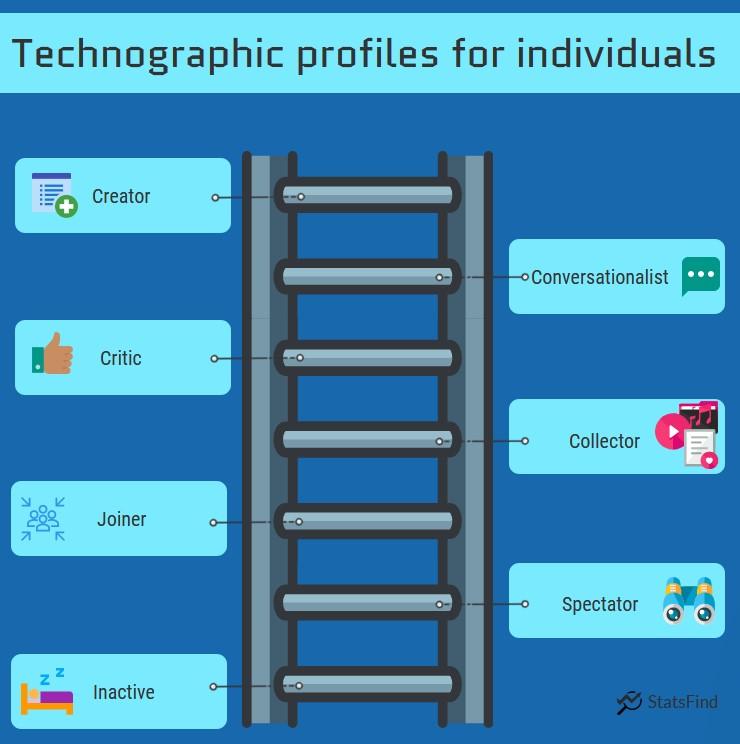We’ve heard of demographics and geographics, but what are firmographics, psychographics, and technographics? Why do they matter?
Businesses value data-driven marketing and creating personalized customer experiences. Statistics from firmographics, psychographics, and technographic allow them to do just that.
Let’s start with firmographics.

Highlights:
- Businesses use firmographics to study data from companies they sell to or wish to do so. Firmographics are invaluable for business-to-business (B2B) commerce.
- Psychographics looks at people’s activities, interests, and opinions (AIOs). Businesses use this information to understand what drives consumer behavior.
- Technographics combines the words “technology” and “demographics.” It refers to the statistical data on the ownership and utilization of technology by an individual or business.
Firmographics – A B2B marketing strategy
Simply put, firmographics is the study of company-level demographics. Instead of analyzing the characteristics of individuals and segmenting them, businesses use firmographics to study data from companies they sell to or wish to do so. Hence, firmographics is invaluable for business-to-business (B2B) commerce.
Another term for firmographics is firm demographics.
1. What data points do you find in firmographics?
Typical characteristics that firmographics provide are:
- industry
- geographic location
- company size
- legal status (e.g., individual business, publicly-owned company, etc.)
- performance (e.g., growth rate, profits and losses, etc.)

2. How do businesses obtain the data?
There are two principal methods for obtaining firmographic information. The first approach is an online search. There is plenty of publicly available data on companies. For example, Forbes provides the following statistics on Costco Wholesale:
- Stock price (as of February 4, 2022): $519.77
- Industry: Retailing
- Founded: 1983
- Country/Territory: United States
- Headquarters: Issaquah, Washington
- President, Director, and CEOW: Craig Jelinek
- Employees: 273,000
- Sales: $178.6B
The caveat is verifying that the information isn’t out-of-date.
The second approach is to conduct a survey. Since the status of a business can change quickly, surveys are an excellent way to gather new and relevant figures. Typical survey questions include:
- What is your industry?
- How many people does the company employ?
- What was your revenue last year?
- Which best describes your current growth path?
- A) Growing
- B) Stable
- C)Downsizing
- D)Other (please explain)
- What is your job title, and how long have you been in the position?
- What is the company’s legal status?
- A) An individual firm
- B) Standalone entity
- C) Subsidiary of a larger organization
- D) Limited liability corporation (LLC)
- E) Partnership
- F) Publicly owned company
- G) Privately held company
- H) Other (please explain)
3. How does firmographics help?
There are several benefits to employing firmographics, namely by helping:
- save money in their marketing research
- determine and concentrate on the most relevant leads
- create a more engaging, personalized marketing strategy
- predict a company’s consumer behavior
Psychographics – Segmenting individuals at a distinctive level
While demographics look at gender, age, profession, income, and marital status (to name a few), psychographics look at something else in the individual: how they think. Psychographics study people’s activities, interests, and opinions (AIOs). Businesses use this information to understand what drives consumer behavior.
1. What data points do you find in psychographics?
Five examples of psychographic information are:
- Personality – Typically, marketers look at the five-factor model of personality. Those are OCEAN:
- Openness to experiences
- Conscientiousness
- Extraversion
- Agreeableness
- Neuroticism
- Lifestyle – Is the customer a stay-at-home dad that goes to his child’s soccer games and is involved in the neighborhood watch? Or is she a single, twenty-something programmer who lives alone in an apartment and works twelve hours a day?
- Interests – What hobbies and pastimes does the customer enjoy? Do they like playing an instrument or learning languages? Do they like binge-watching classic Doctor Who?
- Opinions, attitudes, and beliefs – Is the buyer religious? What are their political views? What is their attitude toward work and recreation?
- Behavior – What products does the customer tend to buy? How frequently do they buy it?

2. How do businesses obtain the data?
There are many ways businesses obtain psychographic information:
- Interviewing existing customers
- Website analytics
- Social media
- Focus groups
- Set-top box data
- Surveys
3. How does psychographics help?
Benefits companies derive from psychographics include:
- Targeting advertisements to the social platforms that the customer uses
- Displaying content in line with the buyer’s lifestyle and interests.
- Promoting products that appeal to the consumer.
Technographics – How does the customer use technology?
Technographics combines the words “technology” and “demographics.” It refers to the statistical data on the ownership and utilization of technology by an individual or business. Therefore, technographics are useful in B2B and B2C (business-to-customer) sales.
1. What data points do you find in technographics?
For individuals, a technographic profile could be one of these steps in a ladder, going from least technological involvement to most:
- Inactive – This is a person that doesn’t engage online at all. They don’t create nor look at web content.
- Spectator – This group looks at online content, such as a blog or a video.
- Joiner – A joiner will have online social profiles but doesn’t post.
- Collector – This individual will engage with online content, such as tagging and following people.
- Critic – This group starts to post, such as commenting on a blog, contributing in a forum, or reviewing a product or service.
- Conversationalist – The conversationalist posts status updates and participates in online discussions.
- Creator – A creator has the most involvement online. They create blogs, videos, podcasts, etc.

At a company level, the technological analysis includes:
- software use and renewals
- hardware use and lifecycle management
- networking technologies
- use of social media platforms
2. How do businesses obtain the data?
Businesses may leverage the following tools:
- surveys
- web scraping
- third-party purchases
3. How does technographics help?
There are many benefits derived from technographic data:
- The sales team can target products that solve a technical pain point for an individual or company.
- A business may be approaching renewals, and sellers could use that time to offer new solutions.
- Knowing which technologies a business uses can help sellers target that business when the technology makes announcements on features or version changes.
Firmographics, psychographics, technographics… What’s next?
Did you enjoy this overview of firmographics, psychographics, and technographics? StatsFind regularly publishes articles on statistics from various fields, trending topics, and events throughout history that pique interest.


